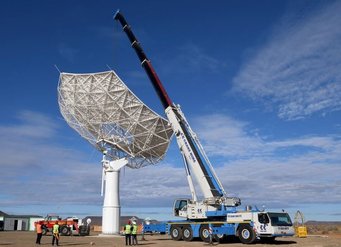Joining the Square Kilometre Array
Max Planck Society becomes newest member of SKA Organization
The Max Planck Society has become the 13th member of the SKA Organisation, following an unanimous vote by the SKA Board of Directors. The decision to accept the application for membership was taken at the 29th Board meeting at SKA Organisation Global Headquarters in the UK.

The Max Planck Society joins the final phase of the SKA Organisation, which is overseeing the telescope design phase, until the process of transitioning into the SKA Observatory, an intergovernmental organisation (IGO) established by treaty to manage the construction and operation of the SKA, is completed. Any further German engagement with a joining of the SKA Observatory remains to be decided and will be subject to future discussions.
“I am delighted to welcome the Max Planck Society to the SKA Organisation as our 13th member, a deserved recognition of the significant contributions Germany has made to the SKA project over the years, and particularly in this crucial pre-construction phase”, said Chairperson of the SKA Board of Directors Dr. Catherine Cesarsky.
German research institutions and industry have been an intrinsic part of SKA-related projects since its earliest days, and have significant involvement in ongoing SKA design activities. In particular, the Max Planck Society provides instrumentation in the form of detectors, data acquisition and analysis systems for South Africa’s world-class MeerKAT telescope, an SKA precursor facility which will become part of SKA-Mid.
“I am extremely pleased to see our German colleagues consolidating their long-lasting involvement in SKA-related activities both at a scientific and industrial level”, added Prof. Philip Diamond, SKA Director-General. “Germany’s great wealth of expertise in radio astronomy, both in science and engineering, will continue to be invaluable as we move ever closer to SKA construction and operations.”
The Max Planck Society is a non-profit organisation with 84 institutes and research facilities. In collaboration with other German institutions and industry, it has been involved across many areas of SKA design work, including within the Mid Frequency Dish Array, Low Frequency Aperture Array, Central Signal Processor, Science Data Processor, Telescope Manager, Signal and Data Transport consortia, and research and development work within the Phased Array Feeds and Wideband Single Pixel Feeds consortia.
Among the Max Planck Society’s institutes is the Max Planck Institute for Radio Astronomy (MPIfR) a key player in the SKA’s Dish engineering consortium. Together with German industry partners, such as the telescope antenna specialists MT Mechatronics (MTM), and international partners, the Dish consortium is responsible for designing the SKA’s mid-frequency array (SKA-Mid), to be deployed in South Africa, The Dish consortium has already delivered two prototype SKA dishes: SKA-P, which is currently being tested in China, and SKA-MPI, funded by the Max Planck Society, which is under construction on the SKA site in South Africa’s Karoo region.
“The SKA is a great opportunity for astronomers, engineers, physicists and data scientists. Besides becoming an amazing discovery machine, SKA pushes the boundaries of what is technically possible, especially in the handling and analysis of huge amounts of data. The Max Planck Society is in the middle of all these exciting science and technology developments, and we are pleased to now be able to contribute officially to the SKAO efforts”, says Prof Michael Kramer, director at the MPIfR.












